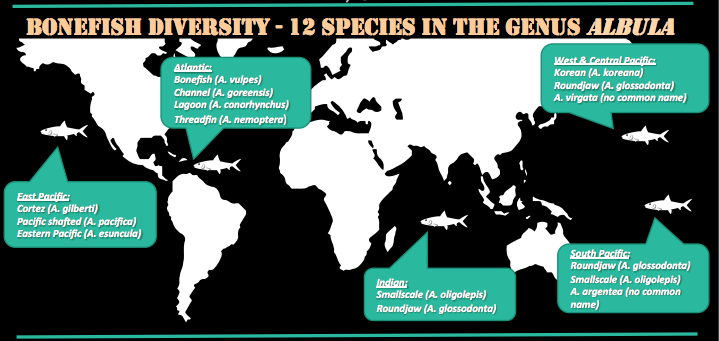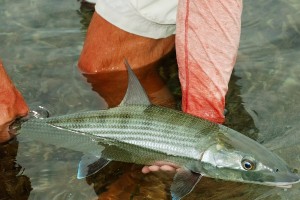We recently received a question from a member about which species of bonefish occur in the Indian Ocean. We’ve also received a number of recent reports of bonefish being caught up the coast of Florida in places like Tampa, which also came with lots of questions. We figured it would be a good time to provide some info about the different species of bonefish you might be catching, so we turned to the foremost expert on global bonefish, Dr. Liz Wallace. You can also read an article by Dr. Wallace on Indo-Pacific bonefish in the current BTT journal.
Let’s start with the question about the Indian Ocean. There are two species of bonefish in the Indian Ocean: The roundjaw bonefish (scientific name Albula glossodonta) and the smallscale bonefish (Albula oligolepis). Much like bonefishes elsewhere, they are very similar in appearance (making visual identification difficult) so in her research, Dr. Wallace used genetic methods to verify species. Both the roundjaw and smallscale occur in the western Indian Ocean, and their ranges extend into the Pacific Ocean. They may use slightly different habitats where they overlap, as we have found in the Atlantic bonefishes. However, more research is needed to determine essential habitat for the Indian and Pacific Ocean bonefishes. Based on available information, the IGFA world record bonefish was likely a smallscale; it was caught in South Africa in 1962 and weighed in at 19 lbs.
Now to the general question, which species of bonefish did I catch? Bonefish are similar in appearance, so genetic identification was necessary to determine the different species. There are 12 species of bonefish that have been identified in the genus albula.

For those fishing in the Atlantic, there are four distinct species. Albula vulpes is the most commonly occurring, and they are the ones you find mostly on the flats. The record Albula vulpes was a 16 pound fish caught in Bimini in 1971. Albula goreensis are the channel bonefish, and are very likely the fish that are caught up the coasts of Florida. If you catch a bonefish near Tampa, it’s likely A. goreensis. Even down in the Keys, people report catching small bonefish in deeper water around reefs, and those are also likely A. goreensis. There are also the less common Lagoon (A. conorhynchus) and Threadfin (A. nemoptera) bonefish in the Atlantic.
If you’re fishing in the Pacific Ocean, which species you catch will vary between the western, eastern and southern regions. Three species are only found in the eastern Pacific, along the coastal Americas: the Eastern Pacific bonefish (A. esuncula), Cortez bonefish (A. gilberti) and Pacific Shafted bonefish (A. pacifica).
One species, A. virgata, has only been documented in Hawaii (though we don’t know if it’s a true Hawaii endemic or if it occurs in low densities in other areas). The other species in Hawaii is the Roundjaw bonefish (A. glossodonta). If you’re catching bonefish on the flats in Hawaii, it’s likely the Roundjaw bonefish. Similar to Albula vulpes and goreensis in the Atlantic, Albula glossodonta and Albula virgata seem to be separated by depth.
Fishing for bonefish in the Seychelles? The smallscale and roundjaw likely coexist (though all the fish Dr. Wallace has analyzed so far have been roundjaw). More information is needed via scale collection.
If you’d like to see the full list of species and some other interesting info about bonefish, check out Dr. Wallace and Karen Murchie’s bonefish infographic.
Keep the great questions coming! And if you’d like to help us collect bonefish fin clips so we can continue to learn more about bonefish genetics, please email info@bonefishtarpontrust.org to request a kit!




